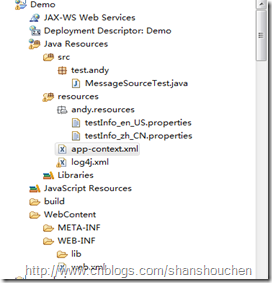Spring中可以使用两个类加载资源文件:
org.springframework.context.support.ReloadableResourceBundleMessageSource
和
org.springframework.context.support.ResourceBundleMessageSource
可配置如下:
ReloadableResourceBundleMessageSource:
<bean id="messageSource"
class="org.springframework.context.support.ReloadableResourceBundleMessageSource">
<property name="basenames">
<list>
<value>andy/resources/testInfo</value>
</list>
</property>
</bean>
ResourceBundleMessageSource:
<bean id="messageSource"
class="org.springframework.context.support.ResourceBundleMessageSource">
<property name="basenames">
<list>
<value>andy/resources/testInfo</value>
</list>
</property>
</bean>
Spring提供了一个接口MessageSource用于获取国际化信息,ReloadableResourceBundleMessageSource和ResourceBundleMessageSource都是继承了该接口的一个抽象实现类AbstractMessageSource,继承该抽象类的有四个类,分别是:
1、
public class StaticMessageSource extends AbstractMessageSource {
...
}
2、
public class SpringSecurityMessageSource extends ResourceBundleMessageSource {
...
}
3、
public class ReloadableResourceBundleMessageSource extends AbstractMessageSource
implements ResourceLoaderAware
{
...
}
4、
public class ResourceBundleMessageSource extends AbstractMessageSource
implements BeanClassLoaderAware
{
...
}
每个类的用处不同,StaticMessageSource主要用于测试环境,并不用于生产环境,SpringSecurityMessageSource用于Spring security的国际化信息
ApplicationContext实现了MessageSource接口,所以,ApplicationContext自身提供了国际化信息功能
例子如下:
在这里,我们测试Spring提供的国际化信息功能,文件名称为testInfo的Resource bundle中有两个文件,分别为英语,中文,国际化资源文件有一定的命名规范,只有符合命名规范的国际化资源文件才能正确的被Spring读取,国际化资源问及爱你命名规范遵循:${filename}_${languagename}_${countryname},其中${}是需要替代的内容,下划线是必需的分隔符,所以如果你想要定义一个中文国际化文件应该是这样的 testInfo_zh_CN,至于language和countryname的取名请参见java.util.Locale类,里面有详细说明。
Spring配置文件如下(app-context.xml):
<?xml version="1.0" encoding="UTF-8"?> <beans xmlns="http://www.springframework.org/schema/beans" xmlns:xsi="http://www.w3.org/2001/XMLSchema-instance" xmlns:context="http://www.springframework.org/schema/context" xsi:schemaLocation="http://www.springframework.org/schema/beans http://www.springframework.org/schema/beans/spring-beans.xsd http://www.springframework.org/schema/context http://www.springframework.org/schema/context/spring-context-2.5.xsd"> <bean id="messageSource" class="org.springframework.context.support.ReloadableResourceBundleMessageSource"> <property name="basenames"> <list> <value>andy/resources/testInfo</value> </list> </property> </bean> </beans>
这里定义了一个MessageSource的实现类ResourceBundleMessageSource用户提供国际化功能,为什么这里的id以messageSource命名呢?如果不明白可以查看AbstractApplicationContext的源代码,你会发现里面定义了一个messageSource的属性,并提供了set方法,也就是Spring在初始化时将Spring配置文件(app-context.xml)中id为messageSource的bean注入到ApplicationContext中,这样我们就可以使用ApplicationContext提供的国际化功能了,一下是测试类:
package test.andy; import java.util.Locale; import junit.framework.TestCase; import org.springframework.context.MessageSource; import org.springframework.context.support.ClassPathXmlApplicationContext; public class MessageSourceTest extends TestCase { public void testResourceBundleMessageSource(){ MessageSource messageSource=new ClassPathXmlApplicationContext("app-context.xml"); String username_us=messageSource.getMessage("userName_lable",new Object[1],Locale.US); String username_chinese=messageSource.getMessage("userName_lable",new Object[0],Locale.CHINESE); System.out.println("chinese:"+username_chinese); System.out.println("english:"+username_us); } }
运行结果:
chinese:用户名 english:userName
ReloadableResourceBundleMessageSource和ResourceBundleMessageSource有着微小区别,从字面就可以看出,ReloadableResourceBundleMessageSource可以在不用重新启动服务器的情况下,读取更改后的资源文件
http://www.cnblogs.com/shanshouchen/archive/2012/08/08/2628394.html

